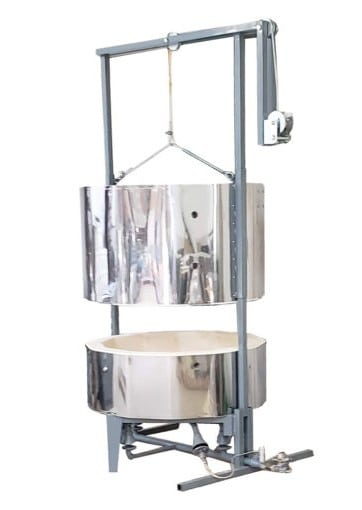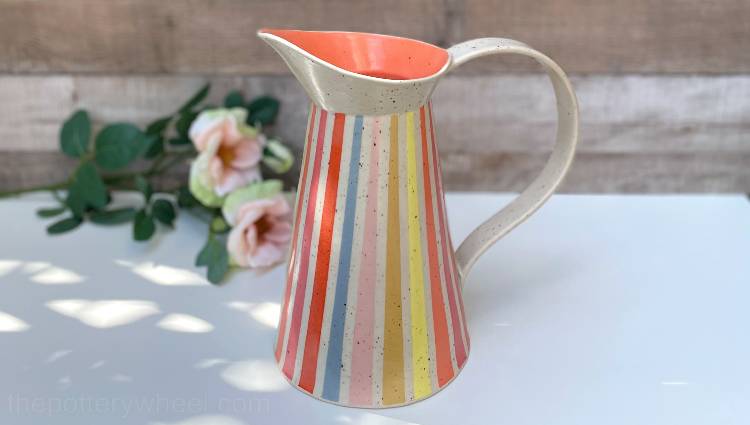Your cart is currently empty!
How Much Does a Kiln Cost? – Buyers Guide
Published:
Last Updated:
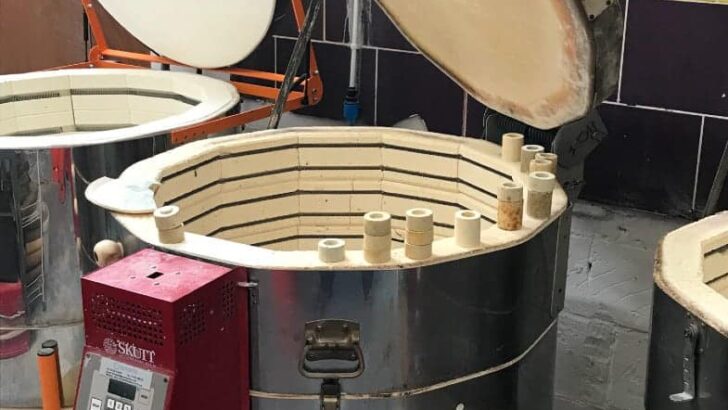
Affiliate Disclaimer
As an affiliate, we may earn a commission from qualifying purchases. We get commissions for purchases made through links on this website from Amazon and other third parties.
If you want to start firing your own work, one of your first questions will be how much does a kiln cost? Buying a kiln is a bit like buying a car as there is a big price range depending on the size and power of the kiln.
Kilns range in price from small tabletop kilns at around $700, to large capacity kilns used by professional potters at around $15000. A medium-sized top-loading kiln will cost between $2000 and $3000. Used kilns can be found for a few hundred dollars, depending on the age and condition.
With kiln prices ranging from $700-$15000, trying to work out exactly how much you will need to spend on a kiln can feel baffling.
However, there are some simple questions that you can ask yourself to decide what kind of kiln you need, and how much it will cost you.
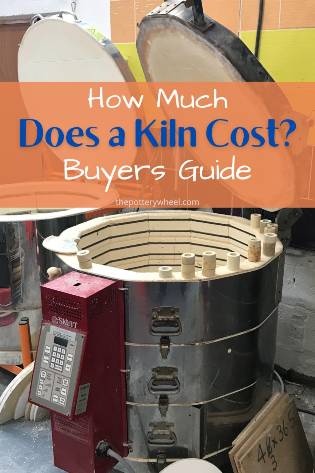
How Much Does a Kiln Cost? – 9 Factors
Here are 9 factors that are important to think about when deciding what kiln to buy.
1) What Do You Want to Fire?
Different types of kilns are used to fire different types of material. Some kilns are meant for firing pottery, others are better for firing glass. Other kilns are intended for firing metal clay.
Some kilns can be used for firing ceramics and/or glass. However, other kilns are more suited to firing glass.
Glass fusing kilns tend to be smaller and flatter. This is because a lot of glasswork is flat. As a result, glass fusing kilns will often have elements on the inside roof of the kiln. The elements are the metal coils that heat up when the kiln is switched on.
By contrast, electric kilns for pottery tend to have elements around the side walls of the inner chamber.
In addition to these differences, glass-fusing kilns usually don’t reach the same temperatures that ceramic kilns can reach. This is because glass melts at lower temperatures than the point at which clay matures.
For example, a glass fusing kiln might typically have a maximum temperature of around 1800F (982C). Whereas this would be considered a low fire temperature for a ceramic kiln.
Price Comparison Range
| Type of Kiln | Lower Price Range | Upper Price Range |
| Glass Fusing Kilns | $950 | $4,200 |
| Pottery Kilns | $1,600 | $15,000 and over |
| Metal Clay Kilns | $600 | $900 |
Glass fusing kilns usually cost less than ceramic kilns. Having said that, some glass fusing kilns are suitable for small low-fire ceramics like ceramic beads, jewelry, and doll heads.
This leads us to look at another factor that it’s important to consider when buying a kiln. And that is the maximum temperature that the kiln can reach.
2) What Temperature do you Want to Fire To?
Kilns have a maximum temperature that they will fire up to. This can be expressed in terms of the ‘cone‘ the fire to, or it can be measured by the maximum temperature reached.
Cones are a way of measuring how much heat (or heatwork) a kiln can put out when it’s firing. If you’d like to know more about cones, you can check out my article here on pyrometric cones.
Often pottery kilns are categorized as firing to cones 6, 8, or 10. A cone 6 kiln will typically have a maximum firing temperature of 2250F (1232C). Whereas a cone 8 kiln will fire to 2300F (1260C) and a cone 10 kiln will fire to 2350F (1287C).
This table may help to make that clearer…
| Cone | Temperature |
| 6 | 2250F (1232C) |
| 8 | 2300F (1260C) |
| 10 | 2350F (1300C) |
It’s important to know the maximum firing temperature of any kiln you want to buy. This is because if you buy a cone 6 kiln, you won’t be able to reach cone 10 temperatures.
In fact, some ceramic kilns are intended to fire mainly at earthenware temperatures and have a maximum firing temperature of around 2100F (1150C). These kilns are best used for low-fire clay and glazes.
So, it’s best to have an idea of what kind of clay and glaze you want to use. And then buy a kiln to suit those preferences.
Does the Maximum Temperature of the Kiln Affect the Price?
There is no hard and fast rule that says a kiln with a higher maximum temperature will always cost more than a kiln with a lower maximum temperature.
However, it is sometimes the case that lower-temperature kilns are less expensive.
For example, the cone 6, Skutt KM 614-3 is the least expensive kiln in the Skutt Kiln Master range. This smaller electric kiln often retails for between $1,600 and $2,000. It is less expensive than the Cone 10 kilns in that range.
But then again, the KM 614-3 is also the smallest kiln in their Kiln Master range too. So, the size of the kiln also plays an important role in the price.
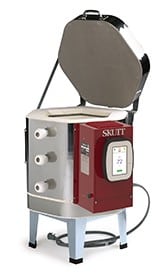
The Skutt KM614 – View on Blick
Having said that, the KM 1227-3, which is a much larger kiln, comes in a cone 5 and a cone 10 model. And the cone 10 model is around $500 more expensive than the cone 5.
So, in the case of the KM 1227-3, the maximum temperature of the kiln is a factor in the price.
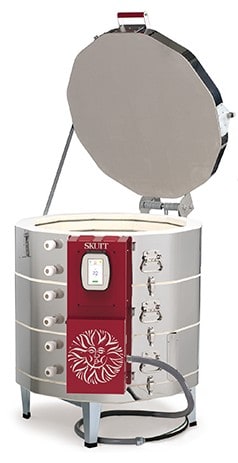
The Skutt 1227-3 – View on Blick
3) What Heat Source Does the Kiln Use?
Some kilns are heated by electrical elements that run around grooves on the surface of the inner chamber. Other kilns are heated by gas (either natural gas or propane).
The majority of potters firing their work at home will use electric kilns. The reason for this is that they are cheaper and easier to buy and use.
It’s commonly accepted that gas kilns are more expensive to buy. It is true that large gas kilns are a considerable investment, ranging from around $7,500 up to $65,000 depending on their capacity.
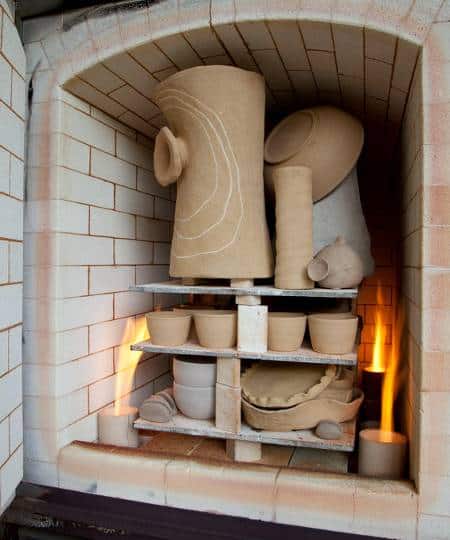
However, gas kilns are not always more expensive to buy. For example, the 2831-Olympic Torch Bearer kiln is a gas kiln. It has almost the same inner dimensions as the electric Skutt KM1231-3PK. And these two kilns both retail in the $4,000-5,000 range and are almost the same price. In fact, the 2831-Olympic gas kiln is just a little bit cheaper.
One of the advantages of using a gas kiln is that you can create a reduction atmosphere when you are firing. ‘Reduction’ refers to when the amount of oxygen available in the kiln is reduced.
Glazes and clay look quite different when they are fired in a reduction atmosphere. They often have an earthier more organic look then glazes fired in an electric kiln.
Because you can now buy smaller gas kilns at the same price as an electric kiln, this makes firing with a reduction atmosphere more achievable.
If you’d like to know more about reduction, you can check out my post on exactly that here.
Raku Kilns
Another popular type of kiln is a raku kiln and these are usually heated using propane or natural gas.
What is different about a raku kiln is that they are designed to be opened when the kiln is at high temperatures.
The pots are then removed using special raku tongs when they are very hot.
To make it easy to remove the pots when they are hot, raku kilns sometimes have a ‘top-hat’ design.
This means that the whole top section of the kiln can be lifted up, giving easy access to the pottery on the base.
Often the hot pots are placed into a closed metal container of combustible material like straw, paper, or leaves. This creates a particular ‘raku look’, on the glazes of the pots.
Raku kilns are a category in themselves. Making a DIY raku kiln for around $200-300 is quite simple. However, raku kilns can also be bought and prices range from $800 – $4,000.
4) Kiln Size
Another factor that will affect kiln cost is its size. Kiln sizes range from the very compact, which can fire a few mugs at a time, to huge kilns that can fire hundreds of pieces at once.
It’s best to figure out how much pottery you generally produce. If you make a few pieces a week a smaller kiln would be sufficient. But if you have a much higher output you will need a larger kiln to fit your work into.
You can take the guesswork out of deciding what size kiln to buy with my handy post here.
The size of a kiln will have a significant impact on its price. For example, compare these three kilns. The capacity of the inner chambers ranges from 0.8 to 18.5 cubic feet. And this is reflected in their prices, which also range from under $2000 to around $8,000.
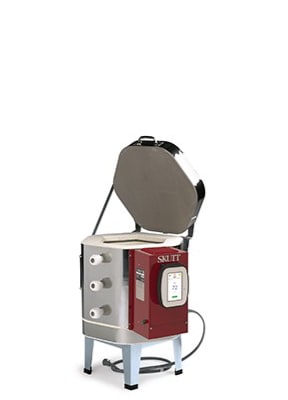

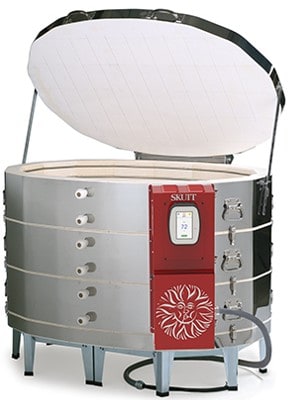
Buyer’s Tip
It’s important to consider the inner and outer dimensions of the kiln.
You will need to know the measurements of the inner chamber to figure out how much pottery you can fire at one time. But you will also need to know the outer measurements of the kiln to figure out how much space you need to store and fire the kiln.
Remember that most kiln manufacturers recommend leaving at least 12 inches, and ideally 18 inches between your kiln and any surrounding surface.
This is because the outside surface of the kiln gets hot when it fires. And you need space between your kiln and other surfaces to allow for air circulation, and also to avoid fires.
5) Power Requirements
Different models of electric kilns will have individual power requirements.
It’s important to check that you have the right electrical supply to support your kiln before you buy it. The power requirements of the kiln are related to price.
Bigger kilns tend to have higher power requirements and larger more powerful kilns are more expensive.
Volts
Kilns differ in the voltage and amperage they require.
Some smaller kilns can be plugged into a 120V domestic wall socket. But most require the kind of 240V socket used by a washer-drier or stove.
An electrician would be able to install this for you. However, this electrical work is an additional expense and needs to be included when you are working out the over budget for your kiln cost.
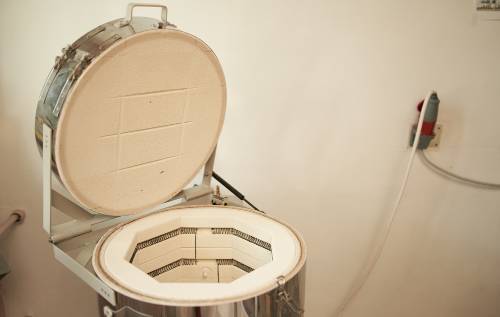
Amps
The amperage required by the kiln is also another potential area of expense. The kiln spec will state how many amps it needs. This can range from 20 amps for smaller kilns to around 80 amps for larger more powerful kilns.
Compare the KMT-714 with the KM-1231…
- The Skutt KM 714 has a chamber capacity of 1.4 cubic feet. Its power requirements are 208-240V, with 20 amps.
- By contrast, the KM-1231PK has a chamber capacity of 11.6 cubic feet. Its power requirements are 208-240 volts, and 44 ½ -80 amps depending on the exact model.
You need to check that your electrical system can manage these requirements. It’s best to consult with an electrician and ask their advice about how your electrical supply may need to be adapted.
Often an electrician will recommend that the kiln be put on its own separate circuit with a breaker switch of its own. The expense of this electrical work is something that you’d need to factor into your kiln cost.
Phase
Single-phase and three-phase power supplies are wired differently. A key difference between the two is that three-phase supplies can carry more power.
Most homes have single-phase power and some schools and larger industrial buildings have three-phase power.
Electric kilns require either single or three-phase power. Be sure to check that your power supply will support the kiln.
6) The Kiln Controller
Kiln controllers are the units, boxes, or knobs on the kiln that control the temperature and speed at which the kiln fires.
Over the years kiln controllers have changed a lot. Old-style kilns are fully manual and their firing schedule is set using a series of dials on the side of the kiln.
Other semi-manual kiln controllers include ‘kiln sitter’ kilns, which are mechanical devices that turn the kiln off when it reaches your desired temperature.
However, more recently kilns have been designed with digital controllers. The most recent development in this area is the touchscreen controller, which is operated much like a smartphone.
Most electric kilns manufactured now have digital or touchscreen controllers. It’s actually quite hard to find a newly made kiln with a manual or semi-manual. However, you can buy new replacement kiln sitters.
The majority of kiln sitter kilns for sale, are used and being sold on second-hand marketplaces like eBay.
More modern kilns with digital or touchscreen controllers are more expensive. Even when you are comparing used kilns, a used kiln with a digital controller will usually cost more than an older model with a kiln sitter. However, this does depend on the condition of the kiln.
7) Is it a Top Loading or Front Loading Kiln?
A lot of kilns have a lid that hinges upwards, and you load your pottery in by leaning over and placing the pots inside the inner chamber. These are top-loading kilns.
Other kilns have a door that hinges on the front and you can load the kiln from the side. These are front-loading kilns.
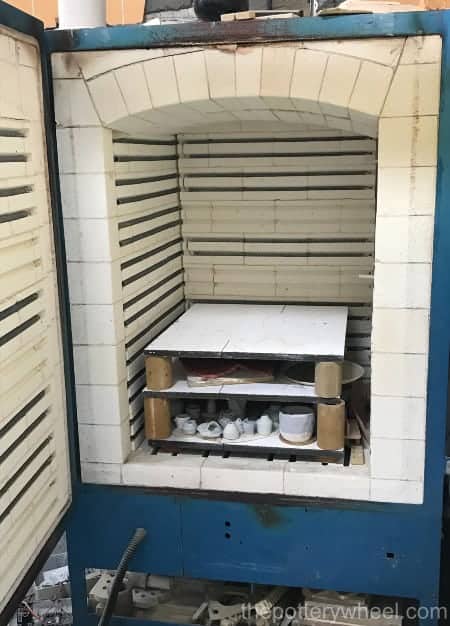
Usually, front-loading kilns cost more than top-loading kilns. This isn’t always the case, and a small tabletop front-loading kiln will be less than a large free-standing top-loading kiln.
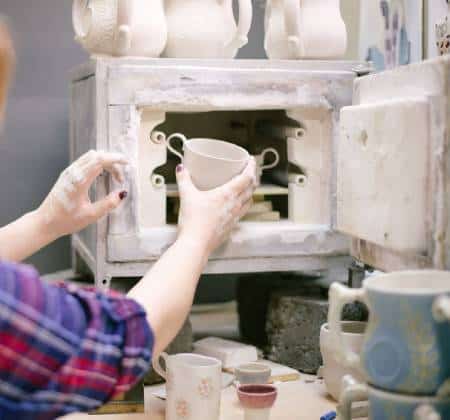
However, if you are comparing kilns that are similar in capacity and power, front loaders are often more expensive. You might expect to pay around $5-6,000 for a top loading kiln with a capacity of around 11 cubic feet. By comparison, a large front loading kiln with an inner capacity of 15 cubic feet could be in the region of $15,000 or more.
8) Buying a New or a Used Kiln
If you have just started out firing your pots, and you can’t stretch to the cost of a new kiln, buying a used kiln can be a great idea.
But, how much does a kiln cost when it’s been ‘pre-loved’? That depends on its age and condition. It also depends on all the other factors outlined above, namely its size, and power.
Nevertheless, you can pick up some very good bargains, at prices ranging from around $200-$1500 or more. Kilns quite often come up for sale on sites like eBay, Facebook Marketplace, and Craigslist.
If you are thinking about buying a used kiln, it’s a very good idea to visit the kiln and see it in person before you commit to buying it. Check it out like you would if you were buying a used car.
If you want more information about the sorts of things to look out for when buying a used kiln, have a look at my post on that subject right here.
It’s good to be clear on what you are looking for when considering a used kiln. If something goes wrong once you’ve bought it, this will add to the kiln cost very quickly. And you might end up paying as much as you would have paid for a new one.
9) Kiln Maintenance
When you are budgeting for a kiln, it’s important to factor in the cost of its maintenance. Kilns are a combination of mechanical and electrical parts that wear out with time and usage.
Components like elements, relays, and thermocouples need replacing at times. So, it’s a good idea to include this in your overall kiln cost.
For example, depending on the temperature you fire your kiln at, you can expect to change your elements every 100-200 firings.
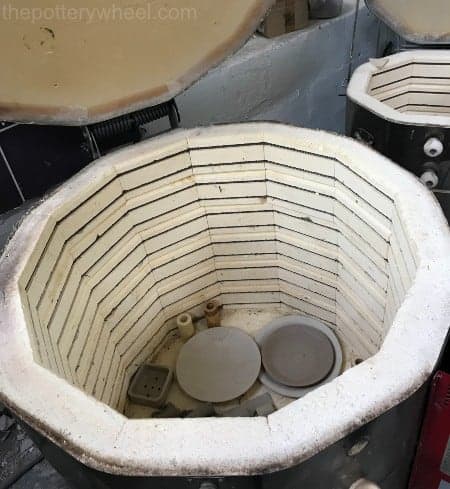
The cost of the elements will depend very much on the size of your kiln. However, a new set of elements for a medium to large-sized kiln cost around $400.
You can learn how to replace these yourself, however, if you want a kiln technician to replace them for you then you will also expect to pay for their labor.
So, when considering the question of how much does a kiln cost, it’s a good idea to include ongoing expenses in your budget too.
Additional Kiln Costs
There are some other expenses that can add to the overall cost of buying a kiln. These include…
Kiln Furniture
Kiln furniture includes the shelves and posts that you will need to load your pots onto in order to fire them.
The size and number of props and shelves that you need will depend on the size and style of your kiln.
However, kiln furniture kits start from around $170 for a small electric kiln with a 1.4 cubic foot capacity. And go all the way up to $870 for a furniture kit suitable for a kiln with a chamber that is 10 cubic feet.
A Kiln Venting System
Firing a kiln creates fumes and gases. Sometimes these smell bad and they can also be corrosive and unpleasant. For that reason, buying a venting system for your kiln might be a good idea.
Certainly, if you are using your kiln in an enclosed space you will need to vent it. Or if you need to be in the same room as the kiln whilst it is firing, then a ventilation system is important.
Some potters have their kiln in the basement of their house or in a spare room. If you are thinking of doing this you will find that the smells and fumes from the kiln will creep through your house when you fire the kiln. One way to avoid this is to install a vent on your kiln that will draw the fumes outside.
You can buy either a downdraft vent which draws the fumes out of the bottom of the kiln and expels them out of a vent in the wall.
Or you can buy an updraft vent that collects the fumes and gases from above the kiln and transfers them outside through a duct in the wall.
The price of a kiln vent will range between $650 and $950 depending on the model and size of vent that you choose. So, it can add a considerable chunk of money to your overall kiln cost if you do choose to install a vent too.
Final Thoughts
Kilns are not cheap, however, if you are fed up with driving your pottery all over town to get it fired, then it might be time to invest in your own kiln.
If you’re buying your first kiln, there are ways you can keep the kiln cost down by buying a smaller kiln or a used kiln. However, it’s good to give yourself something to grow into, and it can be a false economy to buy the smallest kiln you can find. It’s likely that you will outgrow a very small kiln quite quickly and need to upgrade sooner than you’d like.

